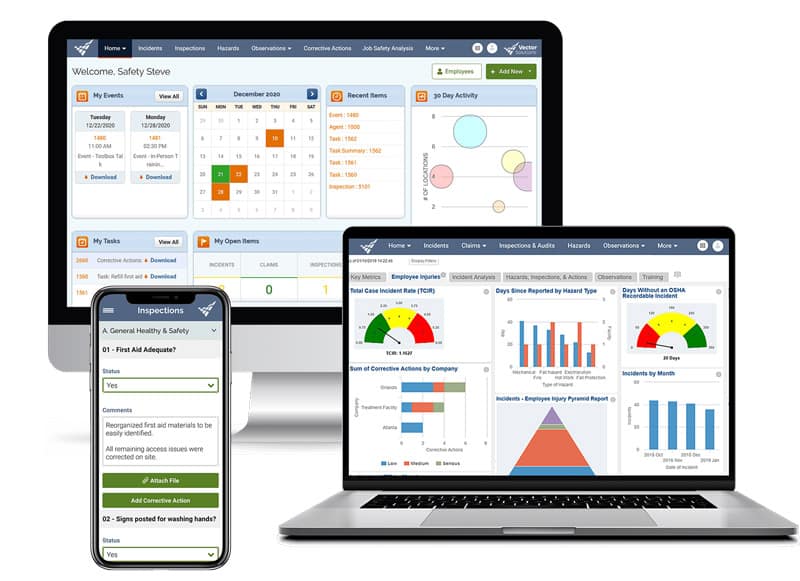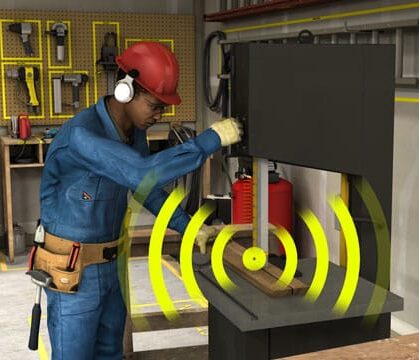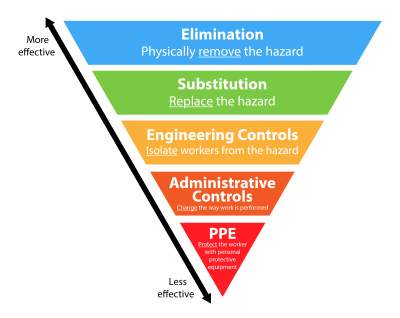March 18, 2019 7 min read
Understanding OSHA construction standards for multi-employer jobsites
Industry:
Solution:
Under OSHA’s Multi-employer Citation Policy, more than one employer at a worksite can be cited for a single hazardous condition that violates an OSHA standard.
This article provides an overview of the policy and explores best safety practices for employers operating at a single workplace.

What is a multi-employer worksite?
A “multi-employer” site is a workplace in which full-time, part-time, temporary, or contract employees that report to different employers are working together onsite.
Many large-scale construction sites containing teams of general contractors and subcontractors are perfect examples of multi-employer jobsites.
Understandably, multi-employer sites can complicate regulatory compliance and make it difficult for employers and their workers to understand their specific safety responsibilities.
This is particularly true when trying to manage training of those on-site. Luckily, we have a free guide on construction training to help you navigate the contractor training landscape.

How does OSHA determine each employer’s responsibilities at a worksite?
OSHA breaks employers down into the following four categories: the Creating Employer, the Exposing Employer, the Correcting Employer, and the Controlling Employer. These categories are not mutually exclusive, as a single employer may perform more than one of these roles.
What are creating employers?
The Creating Employer is the employer who caused a hazardous condition that violates an OSHA standard. A creating employer can be cited in instances where none of its employees are exposed to the hazard but employees of other employers are exposed.
A creating employer can avoid an OSHA fine by simply addressing the hazard(s) it created and complying with the applicable OSHA regulation.
What are exposing employers?
The Exposing Employer is one whose own employees are exposed to the hazard. Employee exposure is established if an OSHA compliance officer witnesses, observes or monitors the exposure of an employee to a hazardous condition during work.
If the Exposing Employer also created the violation, they are citable for the violation as a creating employer.
However, if the violation was caused by another employer, the exposing employer is still citable if they knew of the hazard or failed to exercise due diligence to discover it and protect employees. According to OSHA, if an exposing employer has the authority to correct the hazard, it must do so.
If the exposing employer lacks the authority to correct the hazard, it can still be cited if it fails to do each of the following:
- ask the creating and/or controlling employer to correct the hazard;
- inform its employees of the hazard; and
- take reasonable protective measures. In extreme circumstances, the exposing employer can be cited for failing to remove its employees from the worksite to avoid the hazard.
What are controlling employers?
Employers with supervisory authority over the jobsite and that have the ability to correct OSHA violations or to require others to correct the hazards are defined as the Controlling Employer. This status is established by the contract or by practicing control over a worksite.
The Controlling Employer is not normally required to inspect for hazards as frequently as or to have the same trade expertise or knowledge of the applicable standards as the subcontractor it has hired.
OSHA considers the following factors to determine the appropriate frequency and of inspections and how closely a controlling employer must inspect a job site:
- The scope of the project;
- The nature and pace of the work, including the frequency with which the number or types of hazards change as the work progresses;
- And how much a controlling employer knows about the safety practices of the employer it controls and that employer’s level of expertise.
What are corrective employers?
The correcting employer is responsible for correcting a hazard on-site. They most often are the employer given the responsibility of providing and maintaining safety equipment or devices for the project. Correcting employers can be cited for OSHA violations even in instances in which its employees are not exposed to the hazardous condition. To avoid a citation, the correcting employer must prove they used reasonable care to identify and resolve hazards in the workplace.
How OSHA issues citations
When issuing citations, OSHA follows a two-step process. First, they determine the role(s) of an employer. Then, they determine if the employer took the proper actions to meet their safety obligations.
If employees of more than one employer are exposed to a hazard, citations will normally be issued to each of those employers, the employers responsible for correcting or ensuring the correction of the conditions, and/or the employer causing the conditions.
However, if all employers with workers exposed to a hazard meet the conditions for a legitimate defense, then the citation shall be issued to only the employers who are responsible for creating the hazard and/or who are in the best position to correct the hazard. In these circumstances, the controlling employer and/or the creating employer will be cited even though no employees of those employers are exposed to the hazard. The only exception is when OSHA’s General Duty Clause is used to support a violation. In those cases, only employer(s) whose own workers are exposed to the hazard may be cited.
Best practices for avoiding OSHA violations
Incidents can grind operations to a halt and damage businesses’ reputations, so safety compliance should be a top concern for ALL employers and employees at a worksite. We’ve outlined a few tips below to help employers better coordinate their safety efforts, ensuring your project is completed safely and on time.
Carefully screen contractors whenever possible
You can’t control who other companies hire, but you can double-check your own contractors’ work histories, incident rates, and safety policies. Ideally, before you put the contract out for bid, any potential bidders should complete a pre-qualification process.
Does a bidding contractor have a history of incidents or safety violations at similar worksites? Have they received citations from OSHA previously? Asking these questions ahead of time will help you keep unsafe practices away from your projects.
Develop a master EHS plan for your project
While each employer will bring their own safety plans to a project, a “master” plan should also be developed to ensure consistency. This document should outline safety performance objectives for the project, each employer’s safety responsibilities, as well as communication and reporting strategies for safety issues. This master plan should also clearly set the frequency and scope of site inspections, incident reporting procedures, and outline behavior-based safety observation schedules), and required training courses. All components of this master plan can then be incorporated into employers’ individual safety plans.
Discuss safety in advance
Address every potential safety hazard with contractors and subcontractors before work begins, or before new parties enter a building site in which work is in progress. This gives each employer a chance to identify issues that others may have missed and improve contractor safety management.
Conduct multi-employer training
To make sure everyone is on the same page, collaborate with your contractors and subcontractors to conduct mandatory training sessions and safety meetings as a group before work begins. This is especially important for work that involves multiple employee roles with different training requirements, such as OSHA’s confined space requirements.
This ensures that all workers receive consistent instruction and information about the hazards present on site. To track compliance, you can organize your training efforts and records using a web-based training management system, and encourage other employers to do the same.
Set clear hazard reporting procedures
All employees need to understand how to report safety hazards that they encounter on the job. Using hazard reporting software, employees can easily document hazards, attach photos, and automatically notify key team members of the problem so that it can be corrected quickly.
EHS Management Software for the Construction Industry
Discover a more effective way to manage your safety data.
Learn More









